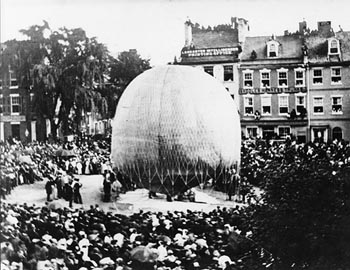John Wise
(1808-1879)

John Wise
As
an adventurous and inquisitive young boy, John Wise was
drawn to the skies above his native
Lancaster
County. He was fascinated by
aerial pursuits and began to conduct experiments. He tied his cat to his
homemade parachute and observed the cat's safe descent from
a local church steeple.
A keen interest in ballooning developed and Wise became a
famous aeronaut. Although balloon ascensions were common at
county fairs and carnivals he had never observed an
ascension before he made his first one in Philadelphia in
1835. John Wise completed 462 balloon ascensions including
Lancaster ascensions from Penn Square and the prison yard.
In the nineteenth century
many ascensions were made just for the novelty of the event,
but John Wise's approach was from a scientific perspective.
Each ascension gave him a chance to conduct scientific
investigations of the atmosphere, pneumatics and
hydrostatics.

"Prof. Wise the Aeronaut"
It also gave him the
opportunity to develop a more advanced flying machine. Wise
was the first to observe the "great river of air which
always blows from west to east" in the higher regions of the
atmosphere. Today we call this phenomenon the jet stream. He
also developed the ripcord safety mechanism.

Balloon Ascension from Lancaster's Penn Square
John Wise promoted the
advantages of balloon transportation. In 1843 he conceived a
project for crossing the Atlantic Ocean and asked Congress
to appropriate $15,000 for the project. Congress rejected
the appropriation. Wise suggested a plan to bomb the Castle
at Vera Cruz during the Mexican War and during the Civil War
the Bureau of Topographical Engineers requested his services
as a balloonist. He is credited with the first airmail
transportation in 1859.
Detailed descriptions of
his ascensions and experiments are found in his book,
Through the Air, published in 1873. The last ascent of
John Wise took place on September 29, 1879 from St. Louis,
Missouri. This flight ended disastrously in Lake Michigan
where his balloon fell and his remains lie.
|
